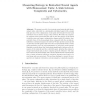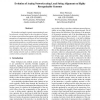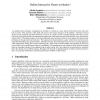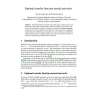401 search results - page 36 / 81 » Evolving a neural network using dyadic connections |
ECAL
2007
Springer
14 years 1 months ago
2007
Springer
Abstract. We present a model of a recurrent neural network with homeostasic units, embodied in a minimalist articulated agent with a single link and joint. The configuration of th...
Publication
We introduce and apply a genetic representation for analog electronic circuits based on the association of character strings extracted from the genome with the terminals and param...
NPL
2000
13 years 7 months ago
2000
In standard neuro-evolution, a population of networks is evolved in a task, and the network that best solves the task is found. This network is then fixed and used to solve future...
GECCO
2010
Springer
13 years 11 months ago
2010
Springer
The Baldwin Effect is a very plausible, but unproven, biological theory concerning the power of learning to accelerate evolution. Simple computational models in the 1980’s gave...
ESANN
2001
13 years 9 months ago
2001
Neural networks use neurons of the same type in each layer but such architecture cannot lead to data models of optimal complexity and accuracy. Networks with architectures (number ...




